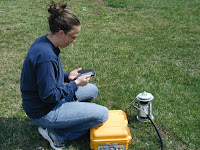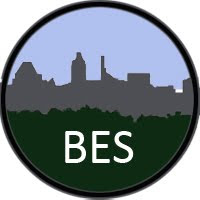Community Awareness and Field Safety Training
Every year, about this time, the Baltimore Ecosystem Study hosts its Community Awareness and Field Safety training. We expect that every new participant in BES, whether student or senior professor, participate in this event the first year they become part of the project. Why do we ask this of the members of a scientific research and education project?
Safety
 |
| Christine Rega sampling soil carbon flux. |
First, the safety part. Every researcher has to be trained in safety. Of course this satisfies formal regulations to train people in procedures to avoid accidents in the field or laboratory. But more fundamentally, it is important for everybody to know what to do to avoid problems, and what to do if some problem occurs. Chemical safety, what fire extinguisher to use for what type of fuel, how to deal with spills, and a long list of other important information needs to be in mind when one enters a scientific workplace. And in the field, how to minimize the risks of exposure to lime disease ticks, or poison ivy, or how to avoid heat stroke, and another long list of issues to be aware of. The rule not to be out in the field alone, whether it is a primeval forest, a stream sampling station, or a city neighborhood, is an important piece of advice for all researchers, for example. BES has developed a good bit of wisdom about the cautions and responses to enhance safety in the field, focusing on the particular dimensions of an urban ecosystem.
Community Awareness
 |
| Baltimore City neighborhoods |
The other half of the event — Community Awareness — is equally important. Furthermore, it is the aspect of working in an urban system that is likely not to be a part of traditional scientific training. It is crucial for success of BES research and education because we are both figuratively and literally working in people’s back yards, and on their streets, and in their school yards, parks, gardens, and farms. Basically, we are working in their neighborhoods. Taking this seriously is one reason that “engagement,” rather than “outreach” is one of the missions of BES. Community awareness promotes the respectful and productive engagement required to work effectively — and safely — in the extraordinarily diverse set of neighborhoods and sites that make up the Baltimore urban ecosystem. For example, by some counts, Baltimore city alone has some 275 recognized neighborhoods. Each has its own leaders, issues, layout, amenities, strengths, and vulnerabilities. Each one has people who care deeply about it, and who keep an eye out for unusual activities or unknown persons. BES researchers and educators — as quests in all these places — need to know when they are cross into a different neighborhood, who are the “gatekeepers” there, what their concerns and interests relevant to science are, and much more. And there is advice from decades of experience — take off your sunglasses, be pleasant, greet people respectfully, take time to let them know what you are doing. Although these are “costs” of doing research in urban ecosystems, they are also rewarding because it can put science in a new light for new audiences. And of course there is the simple pleasure of sharing with new people of many backgrounds.
Unexpected Benefits
The Community Awareness and Field Safety Training is important — and required. It is one practical introduction to the complexities of social-ecological research and engagement with residents and leaders at all levels that make the decisions that determine so much of what constitutes Baltimore’s ecology.
Further Reading
For members of the BES community, the manual is online at http://beslter.org/internal/Guidance-Policies-Safety-BES-Facilities-Manual-2014.pdf You’ll need your BES password to get this.
The Community Awareness and Safety Training is organized on behalf of BES by the Parks & People Foundation, a key participating organization in the project.


